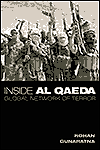| |
BOOK REVIEW
Osama's
universe
Inside Al Qaeda, Global Network of
Terror by Rohan Gunaratna
Reviewed by Sreeram Chaulia
"Look at Osama. Look at his face. He is a good man. He is a
kind man. He is a man of God, He cares for poor Muslims."
- A taxi driver in Jakarta, after naming his baby "Osama my
hero", October 2001
 Sri
Lankan intelligence expert Rohan Gunaratna has drawn on his vast
experience as a consultant to governments on counter-terrorism
and come up with a power-packed and information-filled book on
Osama bin Laden's universe and its dreadful consequences for our
universe. The author personally conducted several hundred hours
of interviews of more than 200 terrorists, including al-Qaeda
members, in more than 15 countries, and thoughtfully compressed
the data into a book elucidating the threat posed by Islamism's
"operational vanguard" and its prospect of "more or less
continuous conflict with the West". (p.2) Sri
Lankan intelligence expert Rohan Gunaratna has drawn on his vast
experience as a consultant to governments on counter-terrorism
and come up with a power-packed and information-filled book on
Osama bin Laden's universe and its dreadful consequences for our
universe. The author personally conducted several hundred hours
of interviews of more than 200 terrorists, including al-Qaeda
members, in more than 15 countries, and thoughtfully compressed
the data into a book elucidating the threat posed by Islamism's
"operational vanguard" and its prospect of "more or less
continuous conflict with the West". (p.2)
Brief history of The Base
Until September 11, Osama bin Laden or his coterie never used
the term al-Qaeda, although the shadowy organization was in
existence since 1989, when the Pakistan-based Maktab-al-Khidmat
(MAK) was converted from an Afghan jihad group into an "Islamic
rapid reaction force" aiding Muslims anywhere on earth.
Sheikh Abdullah Azzam, MAK's founder and mentor of bin Laden,
disfavored expansion into a global terrorist force that would
re-establish the Caliphate through worldwide jihad. It is a
closely guarded secret that bin Laden sanctioned his teacher's
assassination in Peshawar in 1989 due to this fundamental
difference. Azzam's murderers belonged to the Egyptian "family",
who then went on to occupy the top rungs of al-Qaeda.
Ayman al-Zawahiri, Ali al-Rashidi and Mohammad Atef, who held
key positions within al-Qaeda, were all followers of the Salafi
school like bin Laden - a universalist brand of Islamism that
shrugged off sectarian divides and believed in pragmatic
alliances of jihad forces, be they Shi'ite or Sunni, against the
common enemies of America, Russia and Israel. This tendency was
to later bear fruit in al-Qaeda-Hezbollah cooperation (dealt at
length in Yossef Bodansky's book, Bin Laden. The Man Who
Declared War on America). From the early 1990s, bin Laden
invited Islamists of varied strands to join al-Qaeda's shura
majlis (consultative council), thus laying the foundation
for a formidable and gargantuan terrorist network that would
challenge the foundations of world power.
However, widening the orbit did not mean dilution of cadre
skills, as is the case with other terrorist outfits. Quality of
recruits being of paramount importance, al-Qaeda accepted only
3,000 (3 percent) of the mujahideen who trained in Afghanistan
and Pakistan between 1989 and 2001. Al-Qaeda screens out "all
but the most committed, most trustworthy and most capable
operatives". (p.8) It is this exclusivity which has made it
legendary and enviable in the eyes of Islamic fundamentalists
around the world, who may or may not be allied with al-Qaeda.
Al-Qaeda's financial infrastructure was nurtured during bin
Laden's stay in Sudan (1991-1996) as the guest of the National
Islamic Front's Hassan-al-Turabi. Once the Soviets fled
Afghanistan, al-Qaeda fighters expressed restiveness and a
desire to find new pastures to fight. The relocation to Sudan
was with the hope that holy warriors "could go to work again".
In Sudan, bin Laden diversified his businesses by establishing
30 companies, ranging from genetic research labs and civil
engineering to construction and road building. From Sudan, al-Qaeda
spread like a hydra, using communication signposts of the
globalization era like encrypted web sites, satellite
telephones, laptops etc. It was also in Sudan that al-Qaeda
began investing in chemical, biological, radiological and
nuclear weapons.
The aborted Operation Bojinka (the plan in 1994 to assassinate
Bill Clinton and Pope John Paul in Manila and simultaneously
crash 11 US airliners over the Pacific) and the failed
assassination attempt on Egyptian President Hosni Mubarak in
Ethiopia (1995) caused Sudan to request bin Laden's departure
from its soil in 1996. Al-Qaeda's infrastructure in Pakistan was
intact since the Afghan war days and the "Sheikh" decided to
shift back to the original "land of jihad". Using material and
military goodies, bin Laden quickly consolidated his hold on the
Taliban leadership in neighboring Afghanistan, especially the
amir-ul-momineen (commander of the faithful), Taliban leader
Mullah Omar.
While in Pakistan-Afghanistan, bin Laden and Zawahiri engineered
a tactical shift from concentrating mainly on puppet Muslim
rulers of Egypt and Saudi Arabia to a "second front" against the
"King of Satan", America. In 1998, al-Qaeda announced the
formation of "a World Islamic Front for Jihad Against Jews and
Crusaders", and released new fatwa ordering the killing
of Americans. The link between munafiqeen (hypocrites who
pose as "true Muslims") and their sponsors in America became
crystal clear when the Nairobi and Dar-es-Salaam US embassy
bombings (August 7, 1998) were timed to coincide with the
arrival of American troops in Saudi Arabia.
Bin Laden grew in stature of radical Muslims between 1998 and
2000 by calling for the induction of nuclear weapons into
Pakistan's arsenal "to prepare for the jihad", persuading the
Taliban to destroy the Buddha statues in Bamiyan and
successfully bombing the USS Cole in Yemen. The last critical
"gift" of bin Laden to the Taliban before September 11 was the
assassination of Ahmad Shah Masoud, the Afghan resistance
commander, two days earlier. After striking at the heart of
American political and economic assets, the name bin Laden has
become associated with heroism "among many Muslim communities,
from Pakistan to Indonesia and from Nigeria to Egypt". (p.52)
After all, he has achieved what no other force on earth has done
since the British in 1812 - attacked mainland America with
devastating impact.
Organization and ideology
Al-Qaeda is organized on the principles of decentralization and
slippery fungibility. "Under severe pressure, it is likely to
mutate and disperse into less accessible parts." (p.55)
Constituent groups of al-Qaeda operate as a loose coalition,
each with its own command, control and communication structures.
It is a fluid, dynamic and goal-oriented (rather than
rule-oriented) body, whose most potent weapon is the 055
Brigade, a guerrilla group of 2,000 battle-hardened fighters,
comprising Arabs, Central, South and Southeast Asians.
Training camps accept non-al Qaeda jihadis as well and run
cadets through practical and theoretical training far more
rigorous than those of a normal military academy. The 7,000-page
textbook, Encyclopedia of the Afghan Jihad, instructs
trainees on urban, mountain, desert and jungle warfare,
surveillance, counter-surveillance, forging of identity
documents, and conducting maritime or vehicle-borne suicide
attacks. Religious indoctrination is considered more important
than combat preparedness and bin Laden himself addresses elite
students on how "bitter situations came about as a result of
children's love for the world, their loathing of death, and
their abandonment of jihad". (p.74)
Al-Qaeda's finance and business committee - comprising
professional bankers, accountants and traders - runs the group's
funds across four continents. Wealthy Arab benefactors in the
United Arab Emirates, Kuwait, Saudi Arabia and Qatar are the
mainstays, while an extensive web of cover businesses from
diamond-trading, import-export, manufacturing, transport and
Islamic charities and "humanitarian" NGOs (such as the
International Islamic Relief Organization) provide the second
rung of monetary support. In Europe, al-Qaeda's Algerian agents
raise approximately $1 million a month through credit card fraud
and collaboration with organized crime racquets.
Gunaratna credits al-Qaeda for perfecting the art of
"agent-handling", that is, infiltrating political and security
establishments of many countries. "Several Egyptian, Pakistani
and Central Asian police officers and military personnel have
served in the ranks of al-Qaeda." (p.76) Utmost precautions are
taken to reduce the risk of detection of attack plans and
arrangements, as is visible in setting up of small "urban
training camps" all over Europe and North America in private
safe houses, now that the public camps in Afghanistan-Pakistan
have been bombed. Cellular networks that deny knowledge of other
cells or are simply kept ignorant of operatives on different
missions, even within the same town or city, enable high
resistance to intelligence service penetration. "Martyrdom
operations" are so chosen that few fidayeen have past
terrorist records, thereby diminishing the chances of arrest.
Ideological brainwashing and radicalization of Muslim
communities is a very crucial component of al-Qaeda tactics. It
can "draw on the support of some six-seven million radical
Muslims worldwide, of which 120,000 are willing to take up
arms". (p.95). Non-ejection of US troops from Muslim lands is
equated with "sin", and the same abhorrent sin will be invoked
to fresh cadres now regarding US troops in Afghanistan and
Pakistan. "No group has invested so much time and effort as al-Qaeda
in programming its fighters for death." (p.91)
Global outreach
Al-Qaeda is easily the world's biggest multinational
corporation, with branches in nearly 100 countries and countless
billions of dollars in annual turnover. In North America, Sheikh
Kabbani of the Islamic Council admitted, "Islamists took over 80
percent of the mosques in the United States ... the ideology of
extremism has been spread mostly to the youth and the new
generation." (p.103) In fact, bin Laden entrusted the September
11 attacks to Hamburg and Kuala Lumpur cells due to the
knowledge that the FBI was tracking radical American Muslims.
In Europe, most operatives are immigrant Muslims, mainly
Algerians, Moroccans, Tunisians, Libyans and Egyptians. London,
with the infamous Finsbury Park Mosque, was "al-Qaeda's
spiritual hub in the Western world". (p.116) Indian intelligence
revealed recently that a suicide team of al-Qaeda had planned
ramming planes into the British House of Parliament on the same
day as the Pentagon and World Trade Center were smashed. The
interrogation of Sheikh Omar, Daniel Pearl's Pakistani assassin,
has revealed that al-Qaeda's British-based operatives also had a
hand in the suicide attacks on the Jammu Kashmir Legislature
(October 2001), the parliament of India (December 2001) and the
US Information Center in Kolkata (January 2002).
France is a sworn enemy of al-Qaeda due to its support of
"un-Islamic" dictators in the Maghreb. The Algerian Groupe
Salafiste and GIA conduct most of al-Qaeda's propaganda and
terrorist campaigns in France. The Netherlands is a favorite
banking and investment destination of al-Qaeda. Islamists have
also taken over mosques for Muslim immigrants - so much so that,
"in addition to Dutch citizens of Arab origin, there are several
native Dutch converts to Islam openly willing to sacrifice their
lives for Allah and go to Afghanistan". (p.126) Similarly,
Italian and German authorities believe that al-Qaeda recruited
heavily from mosques and madrassas (religious schools).
In the Balkans, up to 4,000 foreign mujahideen fought
against the Serbs and Croats, with the ferocity of killings by
the "guest militants" shocking Bosnian Muslims. In the Caucasus,
around 1,500 Afghan veterans entered Azerbaijan to fight Armenia
over Nagorno-Karabakh, and once fighting ceased there in 1994,
they swiftly moved on to Chechnya-Daghestan (Shamil Basayev was
a bin Laden associate).
Egypt is literally the cradle of al-Qaeda, and bin Laden has
carefully nurtured both Islamic Jihad and the Islamic Group,
bridging the gap between fighting factions and putting up a
united front against the government in Cairo. A "high percentage
of radicalized Egyptian intellectuals, professionals and
military wish to see an Islamic regime in power", forming the
eyes and ears of al-Qaeda in a tightly monitored society. Many
of the Egyptian and North African terrorist actions were
launched from Yemen, whose long-standing Islamic uprising
against communism was bin Laden's favorite cause since
childhood. Saudi Arabia, like Egypt, is a virtual police state
and disallows Islamist activities. But such is the aura of bin
Laden here that al-Qaeda raises most of its funding from wealthy
patrons, with some "pious" individuals donating $1.6 million a
day to "Islamic causes".
Iran, Syria and Lebanon play important subsidiary roles for al-Qaeda
due to the Hezbollah connection. Imad Mughniyeh helped al-Qaeda
develop agent-handling and bombing big urban buildings. In
Israel and the occupied territories, al-Qaeda has a wellspring
of associates in Hamas and Islamic Jihad, and the fact that bin
Laden is viewed as the successor of Abdullah Azzam adds to his
legitimacy.
Islamists see Africa and its 200 million Muslim inhabitants as
al-Qaeda's "newest theater". Bin Laden's followers strongly
believe that the Horn of Africa is "facing a furious Christian
onslaught". (p.152) Al-ittihad-al-Islamiya, an al-Qaeda outfit,
claims responsibility for the Mogadishu ambush of 1993 which
"drove the crusaders out". In Sudan, although al-Turabi has been
imprisoned and President Bashir is dishing out leads on al-Qaeda
to the US, "the threat posed by Islamists has not diminished and
is likely to resurface". (p.157) Ninety percent of the Islamic
NGOs in Uganda were either established or operated by Arabs with
al-Qaeda leanings.
Eastwards, in Tajikistan, bin Laden supported the Islamist
struggle to topple the Russian-backed communist government, a
conflict spilling into a full-scale civil war after 1991. Uzbek
Islamist, Juma Namangani, is said to be an avid bin Laden
follower and his IMU rebels have received training in al-Qaeda
facilities. Until October 2001, al-Qaeda camps in Afghanistan
also prepared Uighurs to fight the Chinese government in
Sinkiang.
In the Philippines, the Abu Sayyaf Group's organization,
ideology and target-selection are deeply influenced by al-Qaeda.
Through the Moro Islamic Liberation Front (MILF), bin Laden's
battalions have penetrated domestic and international Islamic
entities based in Southeast Asia. Jemaah Islamiyah is al-Qaeda's
"Asian arm", aiming to establish "an Islamic republic unifying
Malaysia, Indonesia, Brunei, southern Thailand and Mindanao".
(p.192)
The Indian subcontinent is fertile ground for al-Qaeda "sleeper"
and active agents. Pakistan is "the single most important refuge
other than Afghanistan, before and after 9/11". (p.205) Al-Qaeda
members are present in all major Pakistani jihad outfits
fighting India in Kashmir, that is Harkat-ul-Mujahideen (HuM),
Jaish-i-Muhammad, Hizb-ul-Mujahideen and Lashkar-i-Toiba. Al-Qaeda
influenced a change in their strategy by "encouraging and
assisting them to strike at the heart of India-New Delhi and the
major cities rather than in the periphery of Jammu and Kashmir".
(p.206)
Gunaratna speculates that the reason that Pakistan did not
extradite Sheikh Omar to America, unlike previous terrorists
like Ramzi Yousef, is "because of the complicity of the
Pakistani state in his training" in HuM camps. The author also
quotes from an al-Qaeda manual at a HuM camp: "We saw Russia
disintegrate. Now we will see India fall apart. In the flames of
jihad we will see America ablaze." (p.215) The Bangladesh-based
Harkat-ul-Jihad-al-Islam is also reported to be benefiting from
a 25-member al-Qaeda team imparting sophisticated armed training
since June 2001.
Recommendations
Gunaratna's solutions to counter the "self-reproducing" al-Qaeda
are threefold, surprisingly stressing the non-military over the
military. In the short run, instead of aerial bombardment that
generates negative reactions, "invisible black operations such
as assassination of terrorist leaders should be given priority".
(p.235) If the US unilaterally attacks Iraq, which has no
established connection with bin Laden, "the victor will be al-Qaeda".
In the medium term, Islamism should be prevented from moving
from the margins to the center in Muslim societies and polities.
The battle for the future, to recall M J Akbar's phrase, will be
fought "in the mind". In the long term, schools and community
centers disseminating modern education and humane non-sectarian
values have to be promoted in place of madrassas.
Resolution of outstanding disputes like Palestine and Kashmir
will also take the wind out of bin Laden's habit of adding new
"causes" to his diabolical mission.
Gunaratna has made a valuable intelligence-redolent intervention
into the burgeoning market of bin Laden literature. Policy
makers and private citizens would be well advised to read
Inside Al Qaeda for their own good.
Inside Al Qaeda, Global Network of Terror by Rohan
Gunaratna, Columbia University Press, New York, 2002. ISBN:
0-231-12692-1. Price: US$22.95, 272 pages.
(©2002 Asia Times Online Co, Ltd. All rights reserved. Please
contact[email protected]
for information on our sales and syndication policies.)
|
| |
|
|
 |
|




 Sri
Lankan intelligence expert Rohan Gunaratna has drawn on his vast
experience as a consultant to governments on counter-terrorism
and come up with a power-packed and information-filled book on
Osama bin Laden's universe and its dreadful consequences for our
universe. The author personally conducted several hundred hours
of interviews of more than 200 terrorists, including al-Qaeda
members, in more than 15 countries, and thoughtfully compressed
the data into a book elucidating the threat posed by Islamism's
"operational vanguard" and its prospect of "more or less
continuous conflict with the West". (p.2)
Sri
Lankan intelligence expert Rohan Gunaratna has drawn on his vast
experience as a consultant to governments on counter-terrorism
and come up with a power-packed and information-filled book on
Osama bin Laden's universe and its dreadful consequences for our
universe. The author personally conducted several hundred hours
of interviews of more than 200 terrorists, including al-Qaeda
members, in more than 15 countries, and thoughtfully compressed
the data into a book elucidating the threat posed by Islamism's
"operational vanguard" and its prospect of "more or less
continuous conflict with the West". (p.2) 


